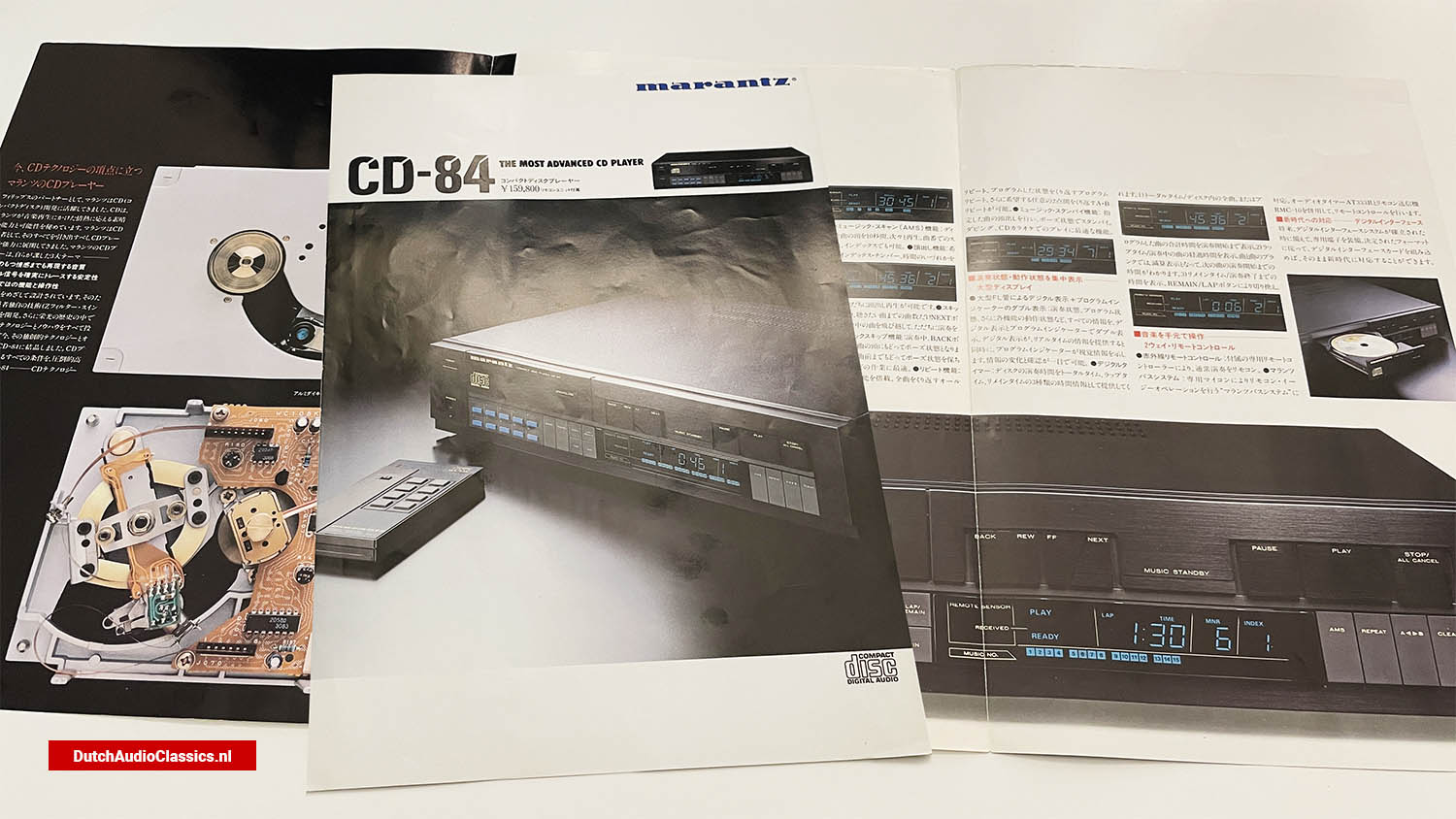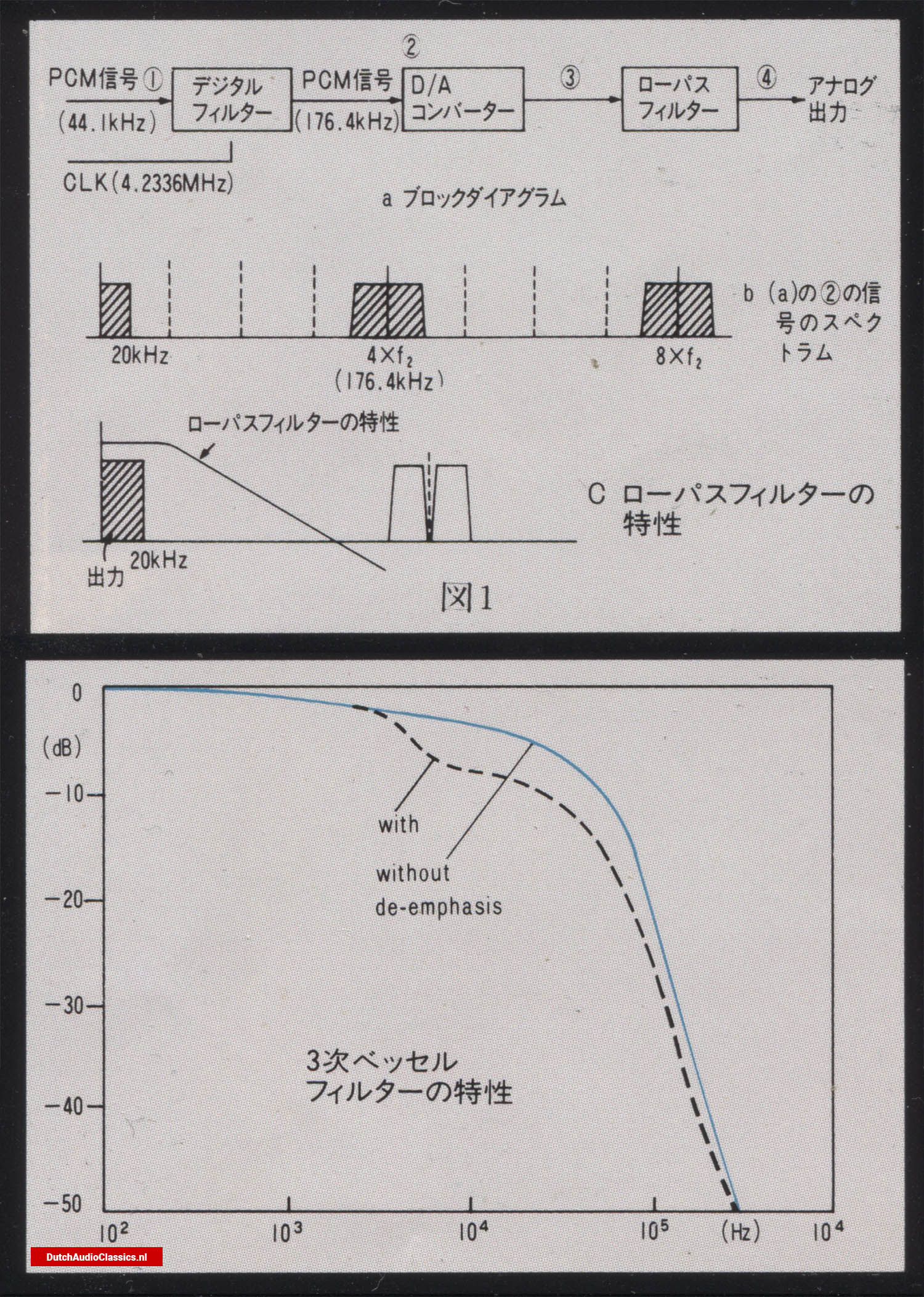As a partner of Philips, Marantz has played an active role in the development of the CD (compact disc), a disc that has the enormous capacity and potential to fulfil Marantz's passion for music reproduction.
As a CD developer, Marantz has developed its CD players with a strong focus on bringing out the best of everything. Marantz CD players are designed to reproduce the three main themes of the CD player
- Sound quality that reproduces the emotion of the music.- Stability to reliably trace digital signals.- Functions and operability unique to CDs.
![Marantz CD84 brochure]()
To achieve this, the CD developers developed their own unique technologies (Z-filter, swing arm, etc.). Furthermore, all the technologies and know-how acquired during the glorious history of the CDs have been put into the CDs. Now, the original technology and audio sensibilities have culminated in the Marantz CD-84, which fulfils all the requirements of a CD player at an overwhelmingly high level.
The Marantz CD-84 achieves all the requirements of a CD player at an overwhelmingly high level.
![Marantz CD84]()
Z-filter
CDs (compact discs) record music information as digital signals. In order for us to listen to it as music, the digital signal has to be converted to an analogue signal (D/A conversion). In CD players, the sampling frequency (44.1Hz) is used in conjunction with this D/A conversion.
The problem is the presence of a low-pass filter that cuts the sampling frequency (44.1 kHz) in conjunction with this D/A conversion. Several problems arise when trying to process the sampling frequency as it is (44.1 kHz). The low-pass filter is of 6~9th order. Ideally 11th order LC filters or active filters are required, and must cut off sharply above 20 kHz. In this case, significant degradation of the phase response, especially phase rotation in the high frequency range, cannot be ignored from an audible point of view. Furthermore, a filter with a sharp cut-off characteristic limits the passband to 20 kHz. At the same time, the transient response is limited to 20 kHz.
Marantz's unique high technology 'Z filter' solves these problems that cannot be neglected in the pursuit of sound quality. The Z Filter is Marantz's unique high-technology solution to these problems. The Z Filter is a further improvement and development of the digital filter: the basis of the Z Filter consists of a digital filter, D/A converter and low-pass filter, as shown in Fig. 1. It is a more advanced and sound-quality refined version of the digital filter system that has been used since the CD-63, Marantz's first CD player.
The Marantz CD-53 is a more advanced and refined version of the digital filter system that has been used since the first Marantz CD-63. The phase characteristics and transient response characteristics are far superior to the standard.
![Marantz CD84 z-filter]()
'Z filter', a further improvement and development of the digital filter
The basis of the 'Z filter' consists of a digital filter, a D/A converter and a low-pass filter. It has been used consistently since Marantz's first CD player, the Marantz CD-63. The phase and transient response characteristics are far superior to the standard.
Phase and transient response characteristics are far from standard.
The 'Z Filter' has a sampling frequency of 4x oversampling 44.1 kHz and can be processed by a low-pass filter with gentle characteristics. The Z-filter uses a low third-order filter, eliminating the degradation of phase and transient response characteristics that occurs with higher-order filters.
Third-order Bessel filter with a passband of 30 kHz
The Z Filter low-pass filter uses a Bessel filter with excellent phase characteristics in addition to a low third-order. The filter ensures good phase characteristics up to high frequencies, while at the same time extending the passband to 30 kHz.
The transient response characteristics have been dramatically improved. The Z filter is the result of the latest technology and audio sensibilities, centred on a digital filter and a third-order Bessel filter. It promises high quality reproduction that reliably conveys even the finest expressions of music.
Clear high frequency reproduction
L/R independent D/A converter
On a CD, the music information is sampled simultaneously and recorded alternately in L and R. When this signal is converted to D/A using a single D/A converter, it is converted to high frequencies at 20kHz. When this signal is D/A-converted by a single D/A converter, a phase rotation of approximately 90° at 20kHz cannot be avoided. A phase rotation of approximately 90 degrees cannot be avoided. In order to reproduce the recording as it was, the L/R independent D/A converter is the best choice.
The L/R independent 2D/A converter converts the L/R signals into D/A signals by means of dedicated D/A converters and outputs them at the same time. As a result, the L/R signals are exactly in phase, reproducing the subtle nuances of the high frequencies without loss of detail.
Absolute tracing capability - Marantz's unique swing-arm pick-up
One of the attractions of CDs is their outstanding playability. Even if you only consider the numerous functionalities that the optical pick-up using a semiconductor laser can achieve, the CD's superb and potential playability is still a mystery.
However, when you consider that what is inscribed on a CD is a digital signal in bits and on the order of microns, you realise that tracing it accurately requires a high level of technical skill. Marantz has responded to this demand with the swing-arm pick-up. The swing-arm pick-up is a unique pick-up drive system from Marantz, one of the CD developers. The swing arm itself, with a shiiser pick-up at the tip and a counterweight at the rear, is fully dynamically balanced. This dynamic balance ensures that the trajectory of the pickup is always stable.
The swing arm itself, which is equipped with a counterweight at the rear, is in a state of perfect dynamic balance. The swinging arm, which is given the correct amount of inertia, is able to withstand shocks from external sources, and is also able to withstand the effects of dirt and scratches on the CDs. The swing arm is also able to clear scratches and dirt from CDs with a minimum of effort. Drop-outs are eliminated.
![Philips CDM1]()
Pursuit of high precision and reliability
The world's smallest semiconductor laser pickup
Along with the swing-arm type drive system, Marantz is proud of its high-technology pickups, the world's smallest and most compact semiconductor laser pickups. The most important part of the optical signal pickup system, which is the most important feature of the CD, is the semiconductor laser pickup. The semiconductor laser pick-up is the most important part of the optical signal pick-up system, which is the most important feature of the CD. The semiconductor laser pick-up requires the irradiation of laser beams into pits on the order of microns. Semiconductor laser pick-ups must be highly accurate and reliable at the same time.
Marantz has pursued this by reducing the size of the pick-up to the absolute minimum. Through miniaturisation, the components of the pick-up have been made extremely simple. The optics have been reduced to just two lenses and one beamsplitter. As a result, a high level of assembly precision can be maintained and reliability has been improved by far. Furthermore, the miniaturisation of the pick-up as a whole has enabled a highly efficient design that makes effective use of only the central part of the laser beam. The centre of the laser beam picks up signals with excellent characteristics such as small L, phase summation and signal-to-noise ratio, with no light wavelength difference. This ensures high-quality reproduction from the very earliest point in time.
Thorough pursuit of sound quality and stability, Upgrading the quality of CD developers' technology
Aluminium die-cast pace: unique swing arm.
Pickups are mounted on a plumi-die-cast base. External shocks and micro-vibrations of the rotating system are shut out for improved stability.
Powerful independent dual power transformers.
The CD player is equipped with one of the largest power transformers and large-capacity capacitors of any CD player. The power supplies for audio circuits and circuits that generate switching noise, such as digital circuits, servo circuits and digital displays, are separated, and noise has been eliminated by adopting a complete independent power supply.
Thorough listening: All components for each stage have been selected through rigorous listening. Furthermore, the best earth point, which is an important factor in determining the sound quality, was also determined through hearings.
![Marantz CD84 specifications]()
All award-winning features
Random-access programme: play between the discs you want to run
- Play between the times you want to. Programs can be up to 2 o'clock.
- DELETE programme: you can skip any number of tracks on the disc that you do not want to listen to.
- Auto Music Scan (AMS) function: plays back the heads of all songs on a disc one after another for 10 seconds. In addition to scanning by song number, it is also possible to use the index.
- The head start function: by specifying the desired track number, index number or time, the head start playback can be performed immediately.
- The unit can also be used as a stand-alone unit, or as a stand-alone unit with a built-in audio system.
- Pressing the BACK button during playback returns to the beginning of the song and pauses it; pressing the BACK button twice returns it to the previous song and keeps it paused. Ideal for dubbing and other tasks.
- Music standby function: the unit can play the head of a specified song and standby in a paused state. This function is ideal for dubbing and CD karaoke play.
Centralised display of playing and operating status
Large FL-tube digital display + programme indicator: All information, including performance status, programme status and the operating status of each function, is displayed on the digital display and programme indicator. The digital display provides real-time information, while the programme indicator provides visual information. Information can be changed and checked in a day.
Digital timer: provides three types of time information about the playing time of a disc: total time, lap time and remained time. 1) Total time/ displays the total time of all the songs on the disc or the programmed songs until the start of the performance. 2) Lap time, displays the elapsed time of the song being played. . The time until the next song starts playing is shown in the display. 3) REMAIN TIME/ Displays the time until the end of the performance, switched by the REMAIN/LAP button.
![Marantz CD84 remote]()
Music control at your fingertips - 2-way remote control
- Infrared remote control: remote control for normal performance with the included dedicated remote controller.
- Marantz Bus system: A dedicated microcontroller allows remote control and easy operation of the "Marantz Bus System".
- Compatible with Marantz Bass System. Remote control is performed by using the Audio Timer AT333R in combination with the remote control transmitter RMC-10.
- Remote control is performed by using the audio timer AT333R and the remote control transmitter RMC-10 together.
Support for a new era - Digital interface
A dedicated terminal is provided in case a digital interface system is established in the future. The digital interface card can be integrated in accordance with the determined format and is ready for the new era.





